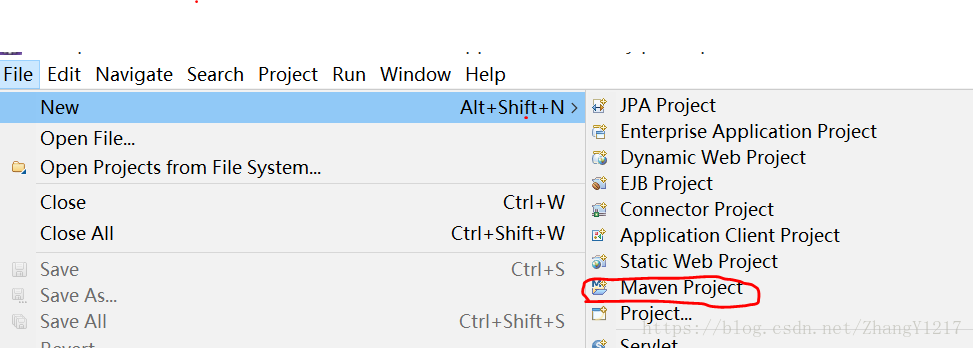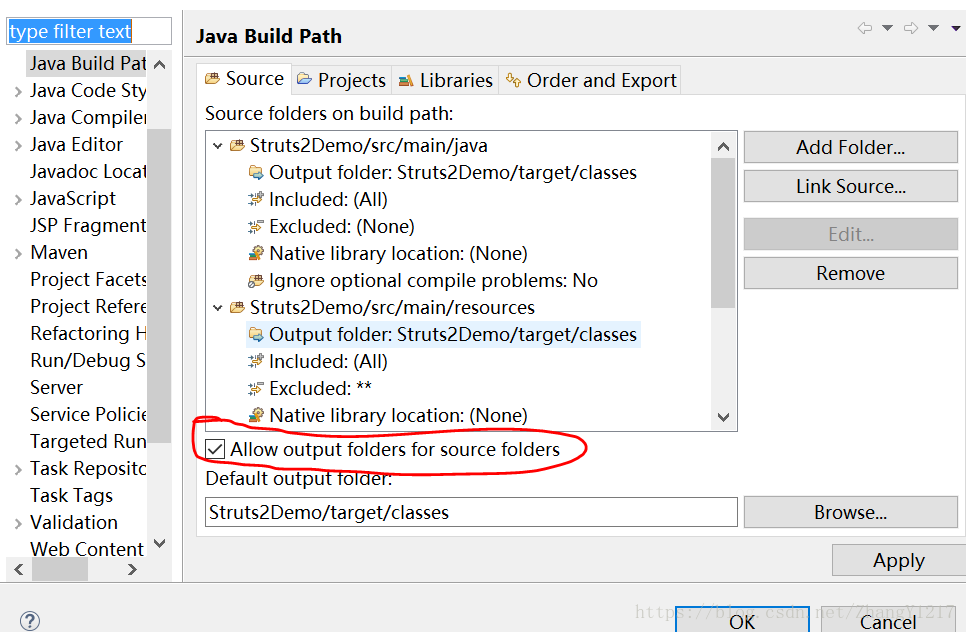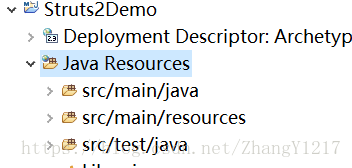Struts2的核心是什么?它和Servlet的关系是什么?
Struts2的核心是interceptor(拦截器);Struts2将Servlet注入到Action中,他们不存在依赖关系。
搭建struts2的步骤
1.首先到官网下载struts2的源码,在其lib中找到所需要的jar包
2.struts所需的依赖:
commons-io
commons-fileupload
commons-lang3
javassist
关键包
struts2-core
xwork-core
ognl----依赖于-->commons-lang3-->commons-fileupload-->commons-io
freemaker-->使用的就是ognl
3.在项目的编译根目录创建固定名称:(struts.xml)配置文件
4.在web.xml中配置struts2的启动过滤器
开始搭建struts2框架并实现文件上传和下载
1.创建maven项目

选则webapp那一项,点击next,输入Group Id 和 Artifact Id.点击finish

当我们创建好了之后会发现一个问题那就是Java Resources中只有一个原文件夹,我们只需要选中项目右键build path,将红圈的勾取消掉然后apply在ok就好了。

正确如下图:

2.在pom.xml中添加依赖:
maven中只需要添加三个依赖就可以了:struts2-core;xwork-core;javassist。我们可以在https://mvnrepository.com/中的所有依赖。如下图:
<!-- https://mvnrepository.com/artifact/javax.servlet/jstl -->
<dependency>
<groupId>javax.servlet</groupId>
<artifactId>jstl</artifactId>
<version>1.2</version>
</dependency>
<!-- https://mvnrepository.com/artifact/javax.servlet/jsp-api -->
<dependency>
<groupId>javax.servlet</groupId>
<artifactId>jsp-api</artifactId>
<version>2.0</version>
<scope>provided</scope>
</dependency>
<!-- https://mvnrepository.com/artifact/javax.servlet/javax.servlet-api -->
<dependency>
<groupId>javax.servlet</groupId>
<artifactId>javax.servlet-api</artifactId>
<version>3.1.0</version>
<scope>provided</scope>
</dependency>
<!-- 这是strust基本的依赖 -->
<!-- https://mvnrepository.com/artifact/org.apache.struts/struts2-core -->
<dependency>
<groupId>org.apache.struts</groupId>
<artifactId>struts2-core</artifactId>
<version>2.3.16.3</version>
</dependency>
<!-- https://mvnrepository.com/artifact/org.javassist/javassist -->
<dependency>
<groupId>org.javassist</groupId>
<artifactId>javassist</artifactId>
<version>3.20.0-GA</version>
</dependency>
<!-- https://mvnrepository.com/artifact/org.apache.struts.xwork/xwork-core -->
<dependency>
<groupId>org.apache.struts.xwork</groupId>
<artifactId>xwork-core</artifactId>
<version>2.3.16.3</version>
</dependency>
<!-- 这是strust基本的依赖end -->
3. 在项目的编译根目录创建固定名称:(struts.xml)配置文件
在src/main/resources中创建struts.xml文件,并且在其中添加检查头dtd,在jar中找到该头部,放进struts.xml中,并且定义根节点

如下图:

4.在web.xml中配置struts2的启动过滤器,配置只有后缀为.do的才处理
<!DOCTYPE web-app PUBLIC
"-//Sun Microsystems, Inc.//DTD Web Application 2.3//EN"
"http://java.sun.com/dtd/web-app_2_3.dtd" ><web-app>
<display-name>Archetype Created Web Application</display-name>
<!-- 过滤器,只有后缀为do的才能通过请求 -->
<filter>
<filter-name>struts2</filter-name>
<filter-class>org.apache.struts2.dispatcher.ng.filter.StrutsPrepareAndExecuteFilter</filter-class>
</filter>
<filter-mapping>
<filter-name>struts2</filter-name>
<!-- /*:过滤所有
*.do:过滤后缀为do的映射
-->
<url-pattern>*.do</url-pattern>
</filter-mapping>
<!-- 配置启动项目时进入的页面,不配置时默认为index.jsp -->
<welcome-file-list>
<welcome-file>index.jsp</welcome-file>
</welcome-file-list>
</web-app>
以上struts2就简单的搭建完成了,可以启动一下,如果不报错就没有问题了。接下来就进行开发文件上传和下载。
1.首先创建一个hello.jsp里面
<%@ page language="java" contentType="text/html; charset=UTF-8"
pageEncoding="UTF-8"%>
<!--使用jstl标签, maven必要添加的东西 -->
<%@taglib prefix="c" uri="http://java.sun.com/jsp/jstl/core" %>
<%@page isELIgnored="false" %>
<!DOCTYPE html PUBLIC "-//W3C//DTD HTML 4.01 Transitional//EN" "http://www.w3.org/TR/html4/loose.dtd">
<html>
<head>
<meta http-equiv="Content-Type" content="text/html; charset=UTF-8">
<title>Insert title here</title>
</head>
<body>
<form action="${pageContext.request.contextPath }/hello/uploadAction.do" method="post" enctype="multipart/form-data">
<input type="file" name="upload"/>
<input type="submit" value="上传"/>
上传结果 :${message}<br>
<a href="downloadAction.do">下载列表</a>
</form>
</body>
</html>创建对应的action类,出来请求
package com.action;
/**
*用于处理用户请求的类
* @author zy
*
*/
public class HelloAction {
//定义处理用户请求的方法:public String 方法名(){}
public String sayHello(){
//success对应于struts.xml的result节点的name
return "success";
}
}在struts.xml中配置action:
<!-- 更改struts2的默认请求后缀:action 或者是 空 -->
<constant name="struts.action.extension" value="do"></constant>
<!-- name:用于继承,唯一标识
namespace:命名空间用于区别同一包下的相同action
-->
<package name="pkg" extends="struts-default" namespace="/hello">
<!-- action->的name:可以理解为servlet中的 映射路径
映射路径:地址栏中项目名之后的则为映射路径
-->
<action name="hello" class="com.action.HelloAction" method="sayHello">
<result name="success">/WEB-INF/hello.jsp</result>
</action>
</package>
<!-- 访问路径:http://localhost:8080/Struts2Demo/hello/hello.do
项目路径:http://127.0.0.1:8080/Struts2Demo
命名空间:/hello
action:/hello
后缀.do
-->
</struts>
xml中的<constant name="struts.action.extension" value="do"></constant>的struts.action.extension是常量,也是在struts2-core的jar包中/org/apache/struts2/default.properties中定义的,还包含了上传文件大小限制等常量。
2.文件上传对应的action
先创建一个常量类
package com.constant;
/**
* 常量类
* @author zy
*
*/
public class Constant {
public static final String UPLOAD_PATH="/files/upload";
}
再创建处理上传的action
package com.action;
import java.io.File;
import java.io.IOException;
import org.apache.commons.io.FileUtils;
import org.apache.struts2.ServletActionContext;
import com.constant.Constant;
import com.opensymphony.xwork2.ActionContext;
public class UploadAction {
/**
* 通过struts2的fileupload拦截器获取file和filename
* upload是前台页面中的name
* uploadFileName中的xxFileName是固定的
* 并且要生成对应的set和get方法组
* @author zy
*
*/
private File upload;
private String uploadFileName;
public File getUpload() {
return upload;
}
public void setUpload(File upload) {
this.upload = upload;
}
public String getUploadFileName() {
return uploadFileName;
}
public void setUploadFileName(String uploadFileName) {
this.uploadFileName = uploadFileName;
}
//定义处理上传的方法
public String upload(){
//业务处理
//获取服务器端文件上传的路径
String realPath = ServletActionContext.getServletContext().getRealPath(Constant.UPLOAD_PATH);
//判断路径是否存在
File fileSave=new File(realPath);
if(!fileSave.exists()){
fileSave.mkdirs();
}
//判断文件是否存在
if(upload!=null){
//在服务器端创建空白文件
File saveFile=new File(fileSave, uploadFileName);
//使用工具类完成文件内容拷贝
try {
FileUtils.copyFile(upload, saveFile);
ActionContext.getContext().put("message", "文件成功");
} catch (IOException e) {
ActionContext.getContext().put("message", "文件失败");
e.printStackTrace();
}
}else{
ActionContext.getContext().put("message", "请选择上传文件");
}
return "upload";
}
}
3.创建下载页面和处理进入该下载页面的action
<%@ page language="java" contentType="text/html; charset=UTF-8"
pageEncoding="UTF-8"%>
<%@taglib prefix="c" uri="http://java.sun.com/jsp/jstl/core" %>
<%@page isELIgnored="false" %>
<!DOCTYPE html PUBLIC "-//W3C//DTD HTML 4.01 Transitional//EN" "http://www.w3.org/TR/html4/loose.dtd">
<html>
<head>
<meta http-equiv="Content-Type" content="text/html; charset=UTF-8">
<title>Insert title here</title>
</head>
<body>
<ul>
<c:forEach items="${files }" var="file">
<li><a href="${pageContext.request.contextPath }/download/downloadFile.do?fileName=${file.name}">${file.name}</a></li>
</c:forEach>
</ul>
</body>
</html>package com.action;
import java.io.File;
import java.util.Arrays;
import java.util.List;
import org.apache.struts2.ServletActionContext;
import com.constant.Constant;
public class DownloadAction {
private List<File> files;
public List<File> getFiles() {
return files;
}
public void setFiles(List<File> files) {
this.files = files;
}
/**
* 定义请求处理
*/
public String download(){
//获取服务器端文件上传的路径
String realPath = ServletActionContext.getServletContext().getRealPath(Constant.UPLOAD_PATH);
//判断路径是否存在,当没有上传文件时就点击下载列表
File downloadFile=new File(realPath);
if(!downloadFile.exists()){
//创建目录
downloadFile.mkdirs();
}
File[] files2 = downloadFile.listFiles();
setFiles(Arrays.asList(files2));
return "download";
}
}
4.创建实现下载的action
package com.action;
import java.io.BufferedInputStream;
import java.io.File;
import java.io.FileInputStream;
import java.io.InputStream;
import javax.servlet.ServletOutputStream;
import javax.servlet.http.HttpServletResponse;
import org.apache.struts2.ServletActionContext;
import com.constant.Constant;
/**
* 文件下载处理类
* @author zy
*
*/
public class DownloadFileAction {
/**
* 下载请求处理方法
*/
public String downloadFile(){
//获取服务器端文件上传的路径
String realPath = ServletActionContext.getServletContext().getRealPath(Constant.UPLOAD_PATH);
//获取文件名称
String fileName = ServletActionContext.getRequest().getParameter("fileName");
//将文件装换成流
try {
// 读出文件到i/o流
File file = new File(realPath+"/"+fileName);
InputStream inputStream=new FileInputStream(file);
BufferedInputStream buf=new BufferedInputStream(inputStream);
//获取request
HttpServletResponse response = ServletActionContext.getResponse();
// 设置response的编码方式
response.setContentType("application/x-msdownload");
response.setCharacterEncoding("utf-8");
// 设置附加文件名
response.setHeader("Content-Disposition", "attachment;filename="
+ new String(fileName.getBytes("utf-8"), "iso-8859-1"));
// 从response对象中得到输出流,准备下载
ServletOutputStream outputStream = response.getOutputStream();
byte[] by=new byte[1024];// 相当于我们的缓存
int k=0;// 该值用于计算当前实际下载了多少字节
// 开始循环下载
while(k<file.length()){
int i = buf.read(by, 0, 1024);
k+=i;
// 将b中的数据写到客户端的内存
outputStream.write(by, 0, i);
}
// 将写入到客户端的内存的数据,刷新到磁盘
outputStream.flush();
outputStream.close();
buf.close();
} catch (Exception e) {
// TODO Auto-generated catch block
e.printStackTrace();
}
/**
* java.lang.IllegalStateException: getOutputStream() has already been called for this response
*是web容器生成的servlet代码中有out.write(""),这个和JSP中调用的
response.getOutputStream()产生冲突.即Servlet规范说明,不能既调用
response.getOutputStream(),又调用response.getWriter(),无论先调用哪一个,在调用第二个时候应会抛出
IllegalStateException,因为在jsp中,out变量实际上是通过response.getWriter得到的,你的程序中既用了
response.getOutputStream,又用了out变量,故出现以上错误。
解决方案:在程序的最后添加:
out.clear();
out = pageContext.pushBody();
Struts2中解决办法
直接让action中的处理方法返回null,问题就解决啦!!!
*/
return null;
}
}
最后的struts.xml
<?xml version="1.0" encoding="UTF-8"?>
<!DOCTYPE struts PUBLIC
"-//Apache Software Foundation//DTD Struts Configuration 2.3//EN"
"http://struts.apache.org/dtds/struts-2.3.dtd">
<struts>
<!-- 文件上传大小最大为2097152字节即2M-->
<constant name="struts.multipart.maxSize" value="2097152000"></constant>
<!-- 更改struts2的默认请求后缀:action 或者是 空 -->
<constant name="struts.action.extension" value="do"></constant>
<!-- name:用于继承,唯一标识
namespace:命名空间用于区别同一包下的相同action
-->
<package name="pkg" extends="struts-default" namespace="/hello">
<!-- action->的name:可以理解为servlet中的 映射路径
映射路径:地址栏中项目名之后的则为映射路径
-->
<action name="hello" class="com.action.HelloAction" method="sayHello">
<result name="success">/WEB-INF/hello.jsp</result>
</action>
<action name="uploadAction" class="com.action.UploadAction" method="upload">
<result name="upload">/WEB-INF/hello.jsp</result>
</action>
<action name="downloadAction" class="com.action.DownloadAction" method="download">
<result name="download">/WEB-INF/download.jsp</result>
</action>
</package>
<!-- 下载文件配置 -->
<package name="download" extends="struts-default" namespace="/download">
<action name="downloadFile" class="com.action.DownloadFileAction" method="downloadFile">
</action>
</package>
<!-- 访问路径:http://localhost:8080/Struts2Demo/hello/hello.do
项目路径:http://127.0.0.1:8080/Struts2Demo
命名空间:/hello
action:/hello
后缀.do
-->
</struts>
运行截图:虽然界面有点low,但是功能实现了



最后
以上就是害羞猎豹最近收集整理的关于maven搭建struts2框架的全部内容,更多相关maven搭建struts2框架内容请搜索靠谱客的其他文章。








发表评论 取消回复